This past weekend saw two of the most intriguing teams of the 2023/24 WSL season come head-to-head: Tottenham Hotspur and Liverpool; both sides are showing positive early signs of improvement from last season.
Spurs came into this match on a four-game unbeaten run, having only lost their opening game of the season to reigning champions Chelsea.
Like Tottenham, Liverpool came into this game having started the season off well, only losing one of their opening five games to Everton and also picking up a win against one of the league’s favourites, Arsenal.
In this tactical analysis, we provide an analysis of some gripping ideas that the two sides looked to implement in relation to their tactics focused on the attacking phase of the game.
Lineups

Spurs lined up in a 1-4-4-2 shape; however, it often appeared more as a 1-4-2-3-1, with Kit Graham playing as a number ten just behind Martha Thomas. The Spurs backline has been a mainstay in Robert Vilahamn’s side, having started with Ashleigh Neville, Molly Bartrip, Luana Buhler and Angharad James for every WSL game so far.
The midfield three, as we’re going to call it, of Graham, Olga Ahtinen and Eveliina Summanen has also been fairly consistent throughout the season. The significant difference is the replacement of Drew Spence for Graham.
The front line of Grace Clinton on the left, Martha Thomas through the middle and Celin Bizet has also been consistent throughout the season and a major reason behind their great start.
Liverpool lined up in a 1-4-3-3 with a back four from left to right of Taylor Hinds, Jenna Clark, Gemma Bonner and Grace Fisk. This was changed from their typical formation this season of 1-3-4-3, with Jasmine Mathews and Emma Koivisto unavailable for this game. This forced Matt Beard’s hand and meant they went with a less familiar back four.
This change of shape meant that Beard’s side played with an extra midfielder, having typically played with two central players, Fuka Nagano and Marie Hobinger. However, the extra midfielder that they deployed was Ceri Holland. Nagano played as the deeper of the three midfielders, while the other two played more advanced and helped support attacks more readily.
In attack, Liverpool have generally played with a front three similar to that they deployed on Sunday. Having played several different players on the wings with the likes of Shanice van de Sanden, Missy Bo Kearns, Mia Enderby, Melissa Lawley and Natasha Flint. In this game, though, they began with Enderby on the left and Lawley on the left; however, after 43 minutes, Enderby picked up an injury and was replaced by van de Sanden. Then, through the middle of the attack, they played with Sophie Haug, as they have done for the majority of the season.
Spurs in possession
Throughout the game, Spurs looked positive on the ball and operated with their two pivots in Ahtinen and Summanen to try and play out from the back. A major theme throughout their time on the ball is how they look to stretch the field even when the ball is on the opposite side, with the full-backs holding their width throughout, always being available to receive a switch pass. This enabled Spurs to make the Liverpool midfield work hard from side to side in an attempt to pull them apart later on.
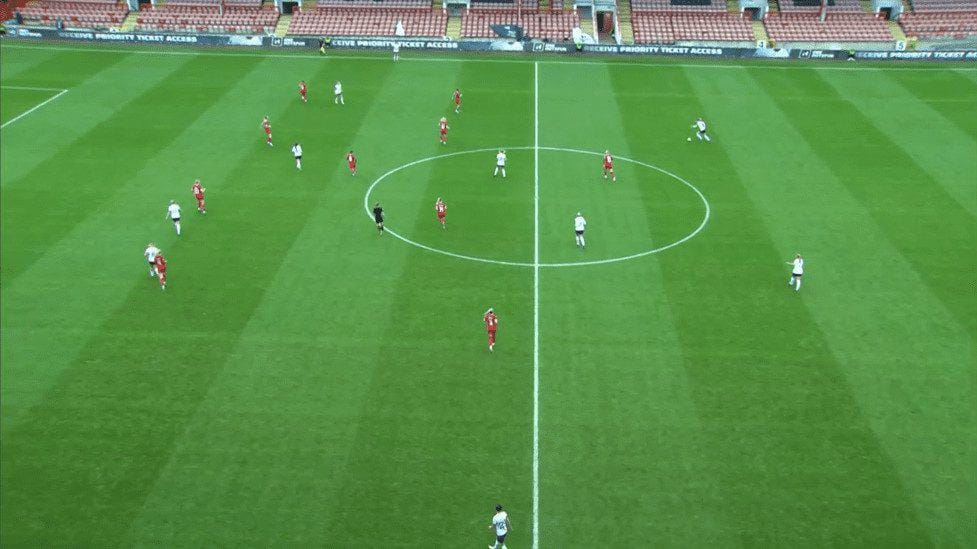
Above, you can see the Spurs shape in possession with the two centre-backs on the ball playing high up the field. The double pivots in the midfield play either side of the Liverpool striker, yet still playing in front of the Liverpool midfield. You can see Neville and James hug that touchline, holding their width.
Then you have the front four with playing right up on the Liverpool backline. Note how they are playing narrower than the full-backs to create that angle to receive the ball. You also have Graham playing slightly deeper in that pocket of space between defensive and midfield lines, just a side note that Liverpool often counteracted this by playing Nagano slightly deeper just in front of the backline to reduce this space.
Another situation that Spurs would look to cultivate is when the Liverpool shape becomes compressed to one side; they would take advantage of their wide in-possession shape and switch that point of attack.
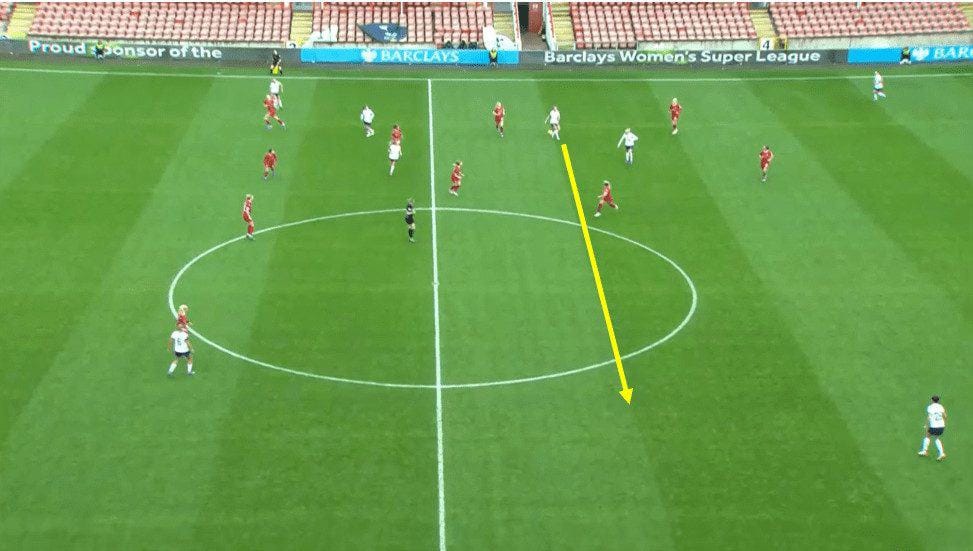
As you can see from the above image, the Liverpool shape has become compressed onto the right-hand side of the field. So, Spurs look to switch the attack to Nevill,e who has all this space to run into and potentially isolate Fisk down the right by combining with Clinton to create a 2v1.
The next interesting thing to note about Spurs in attack is how they looked to draw out the Liverpool high press and use this against them to expose their backline as they pushed players into the attacking third.

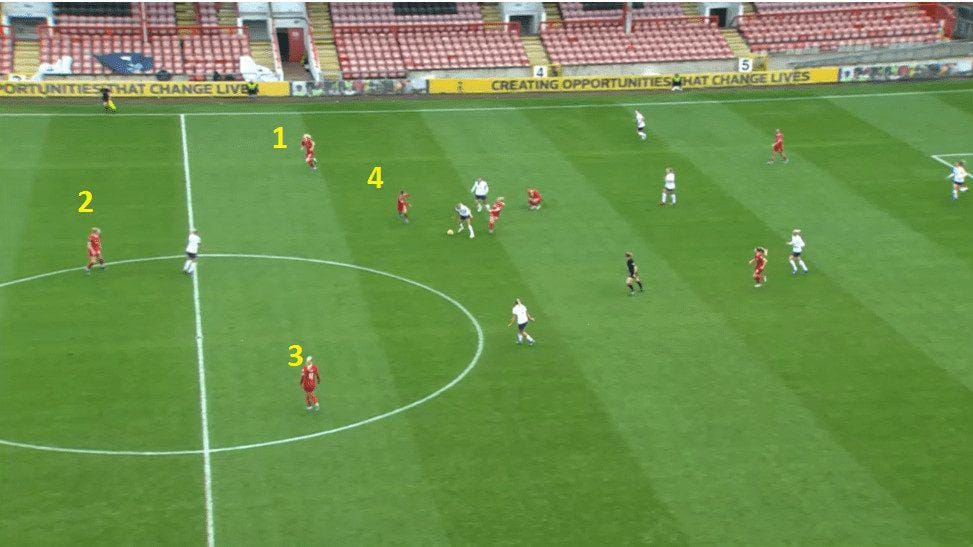
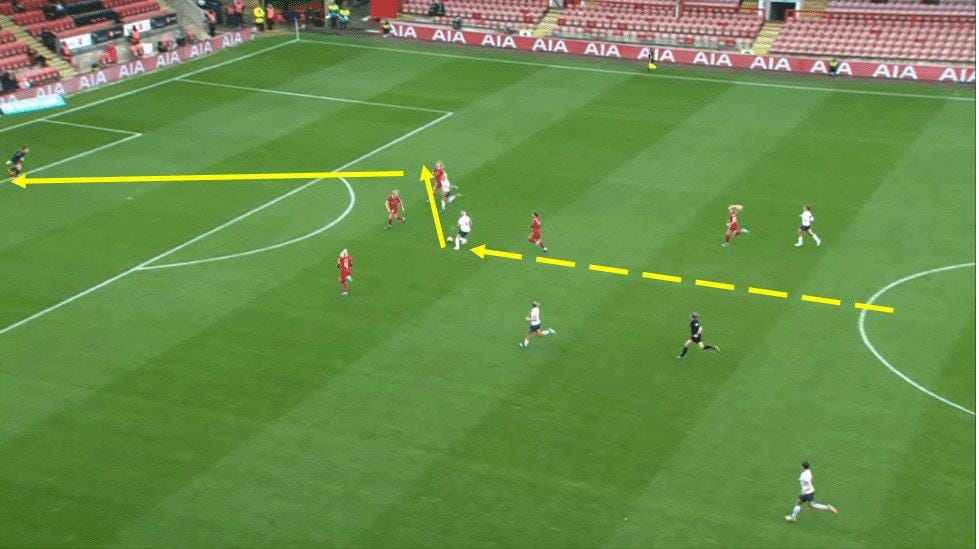
In the first image, you can see how many Liverpool players have been drawn high up the field,d with five Liverpool players within the final third. This means there must only be five Liverpool players behind this ball as it’s played beyond the front five.
Then you can see from the second picture how there are only four players in front of Bizet when she picks up the ball. She is then able to drive forwards with the ball at pace and prevent any Liverpool players from being able to get back in time. Then Bizet drives onto her right side and hits a fantastic shot into the back of the net to open the scoring.
Then you have how Spurs look to target the wide areas. They often progressed the ball quickly up the field from these wide situations by utilising third-player runs and wide triangles. They could get balls into the box from these positions and create goal-scoring opportunities.
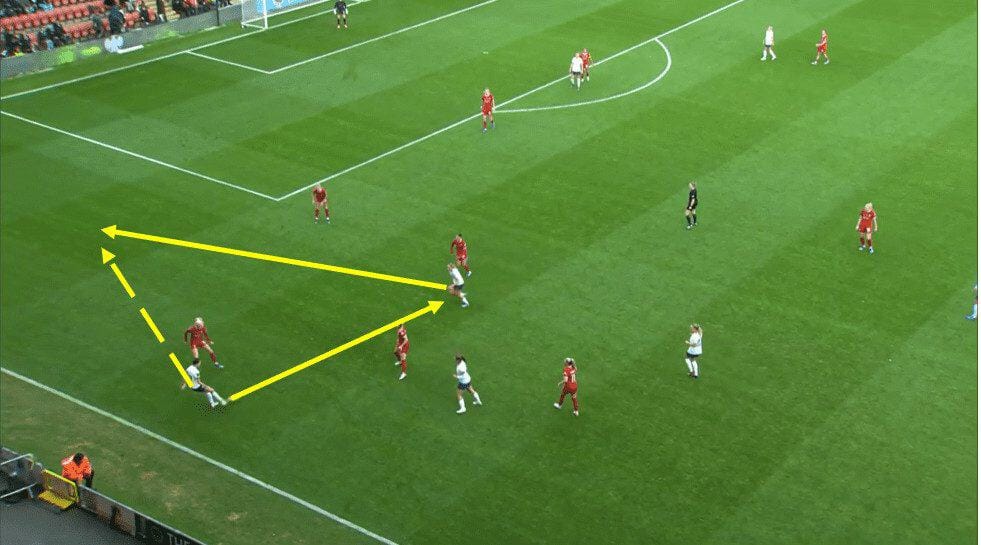
In this above example, you can see that Spurs have packed four players into this wide channel, but what they do to take advantage of this is isolate Fisk with a quick 1-2 where Neville runs into the space behind Fisk, catching her off guard with her hips too square to turn quickly.
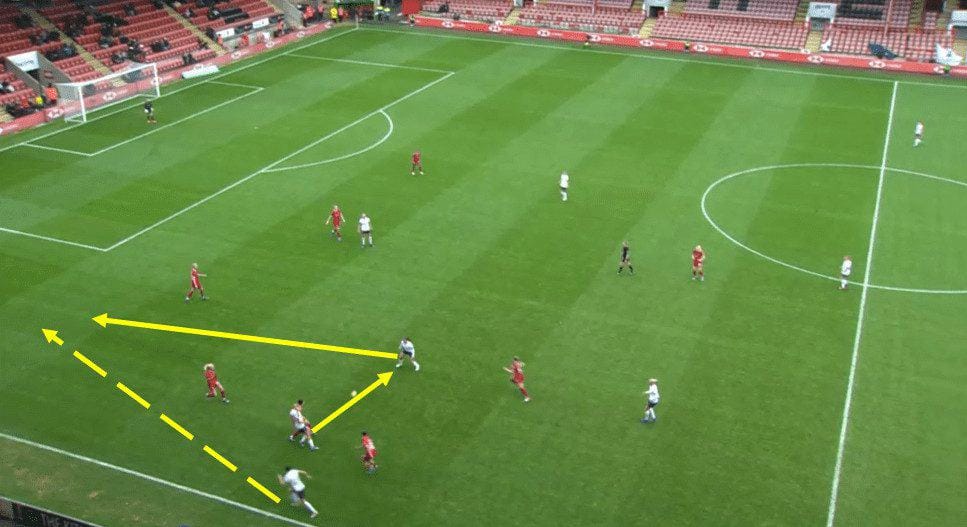
In this above example, you have a third player run by Neville as Graham and Clinton play a pass between each other. Neville again attacks the space behind Fisk, who has been drawn towards the ball and becomes too square. Neville can then get a cross into the box and create a chance for Bizet to flick o,n but it goes just wide.
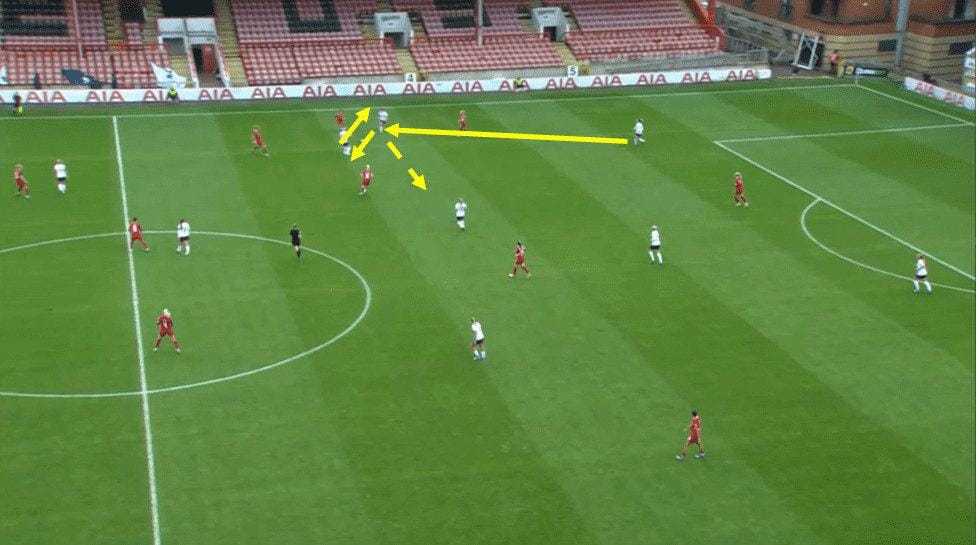
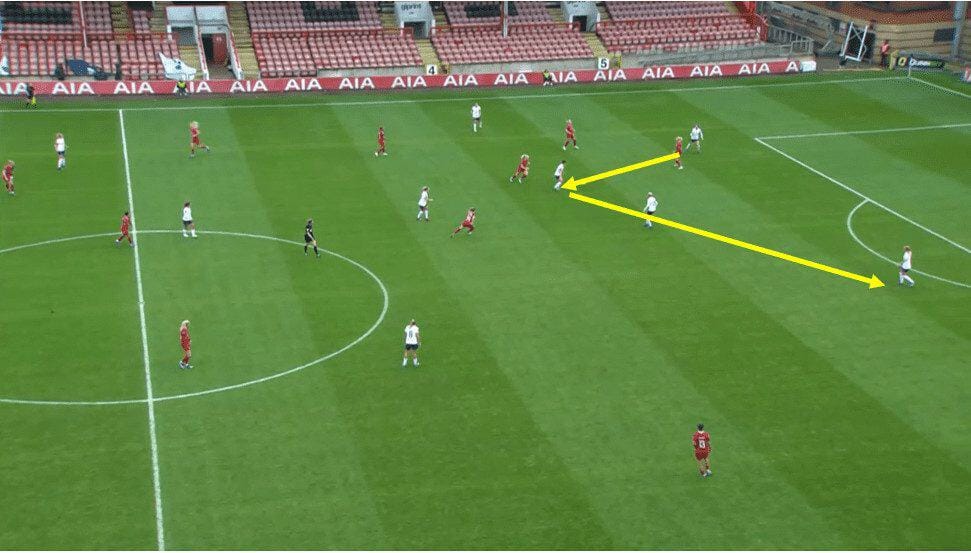
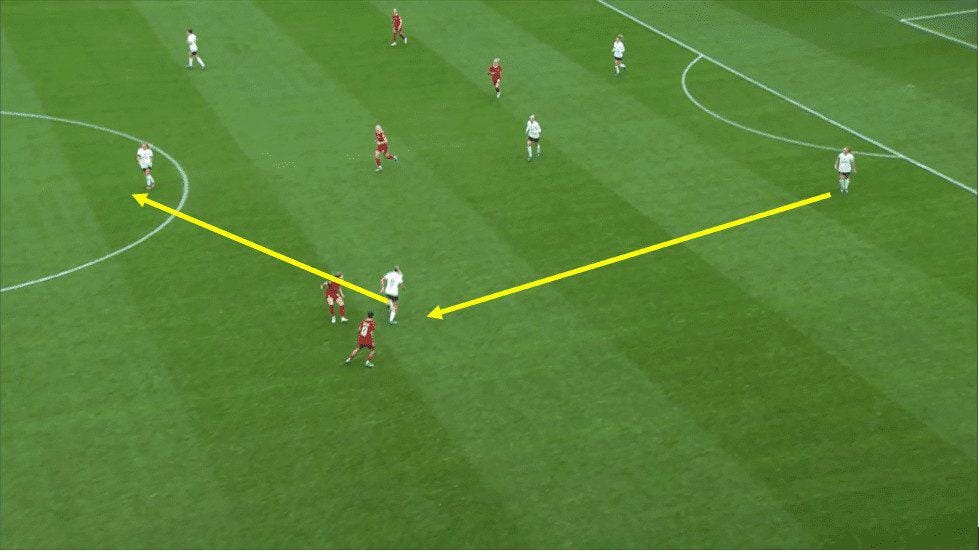
This play is the most impressive sequence from this game, with the ball being played wide initially and then into Bizet, who receives the ball with her back to the goal. Then, Bizet plays the ball back to centre-back Buhler.
The most impressive thing though is the rotations you get in this sequence,e with James and Bizet swapping positions as James follows her pass and works across the field to give the Liverpool defence a different look.
With fewer Liverpool players, the ball is then worked across to the other end of the field. Clinton then receives the ball, turns and then plays the ball to Graham with all this space between the defence and midfield lines. This shows Spurs’ ability to pull apart a press through several different methods.
Liverpool in possession
Similar to Spurs, Liverpool looked to be positive on the ball and build from the back. However, how they did so was very different. The major difference between Liverpool and Spurs is that Liverpool looked to play with just a single pivot in Nagano. Although Nagano was the main pivot player throughout, you would get rotating pivots in the other midfielders, such as Hobinger.
The other notable aspect of the Liverpool attack is how the two centre-backs start outside the two Spurs forwards, making it considerably easier to play around that first line of the press.
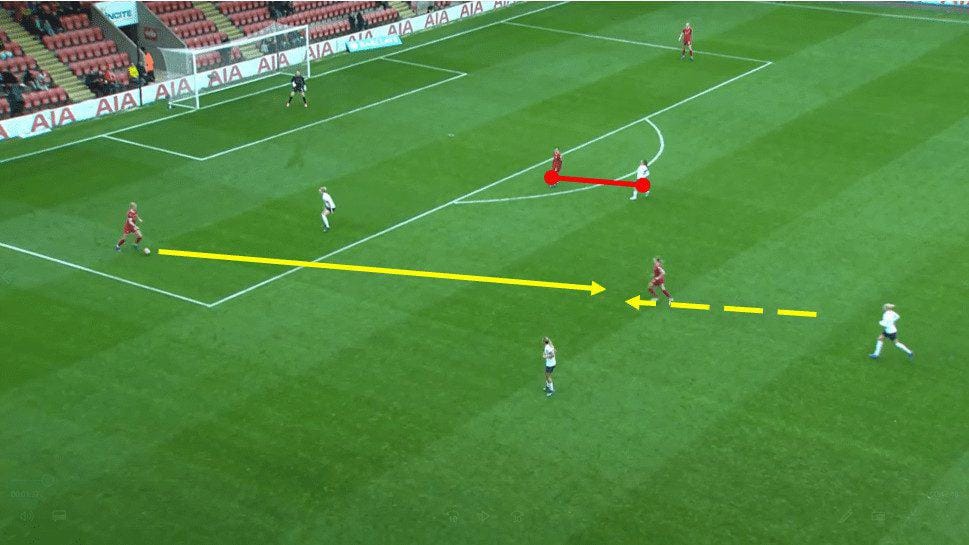
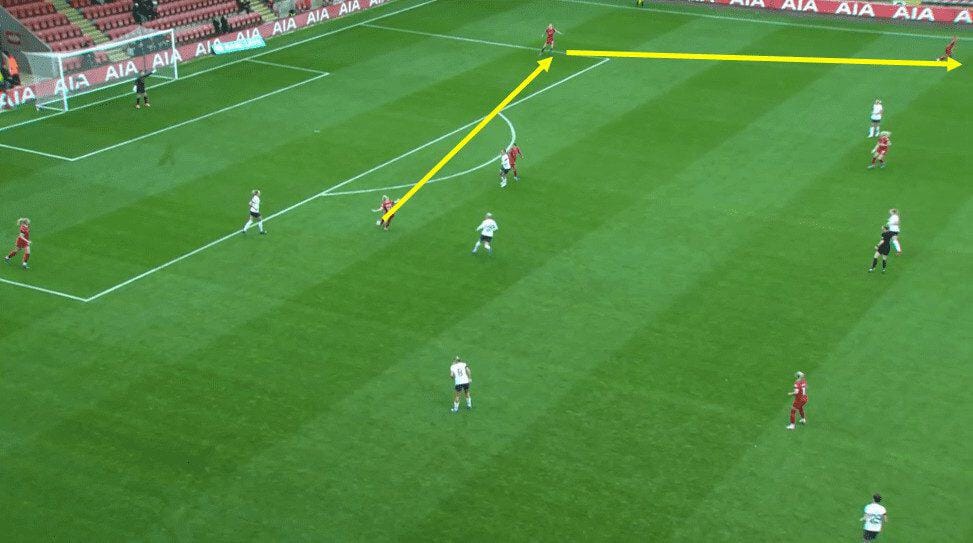
Above, you can see how Spurs look to take away the option of using Nagano by putting Graham directly on her. However, to counteract this, Hobinger rotates deeper and is able to pick up the ball and then in two passes, Liverpool can play the ball into the full-back and has been able to play around the Spurs press.
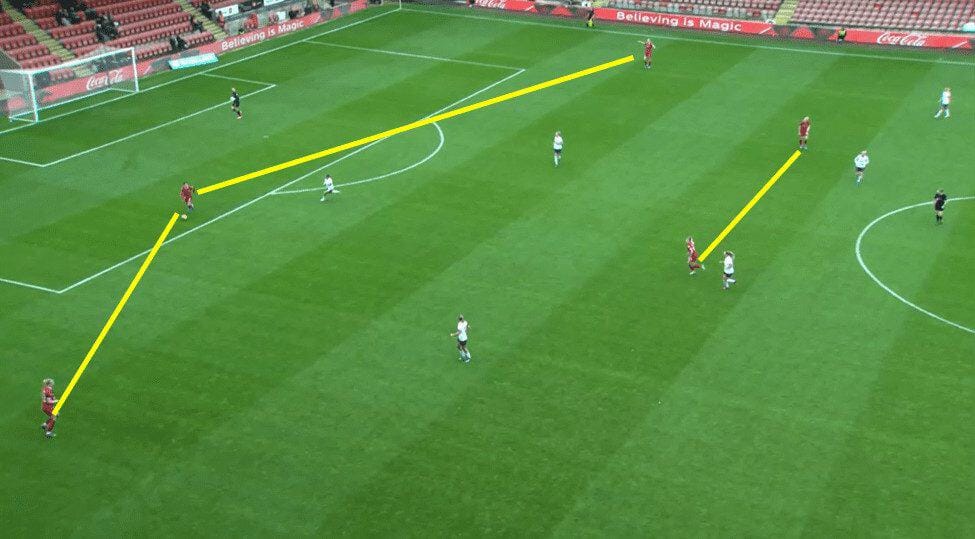
To counteract that, Spurs were trying to mark Nagano out of the game. Nagano was also comfortable dropping deep to become a third centre-back and create a shape more typical of Liverpool this season. Creating that 3-4-3 shape that they have been more often utilising this season.
The next aspect of the Liverpool attack we are going to look at is the sheer speed at which Liverpool can go from build-up to attack. With Spurs pushing high up the field trying to press the ball. Liverpool looked to play around this press with a great deal of success.
When they beat those first lines of the Spurs shape, Liverpool looked to get forwards quickly, and often, you had midfielders and defenders getting forwards to accompany the attacks. Trying to take advantage of situations you would more commonly associate with counterattacks themselves.
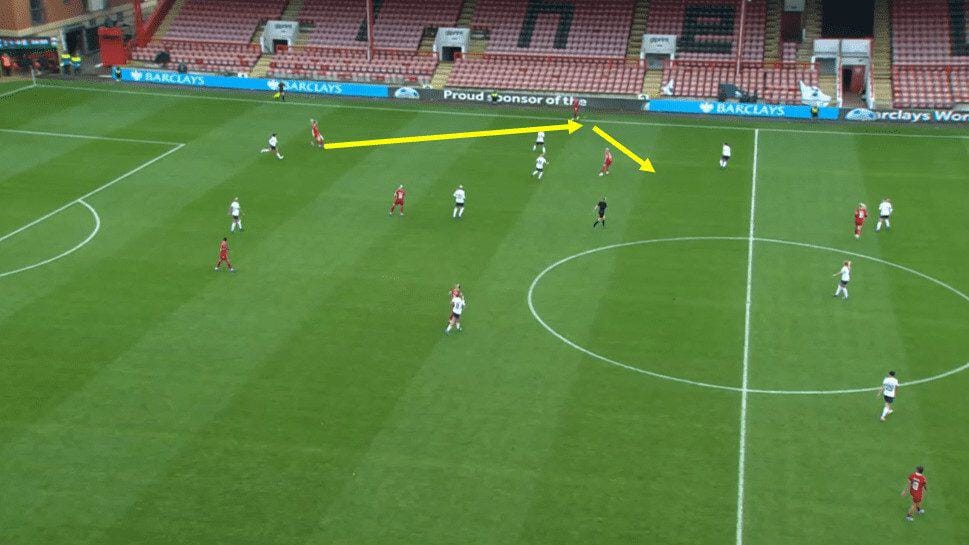
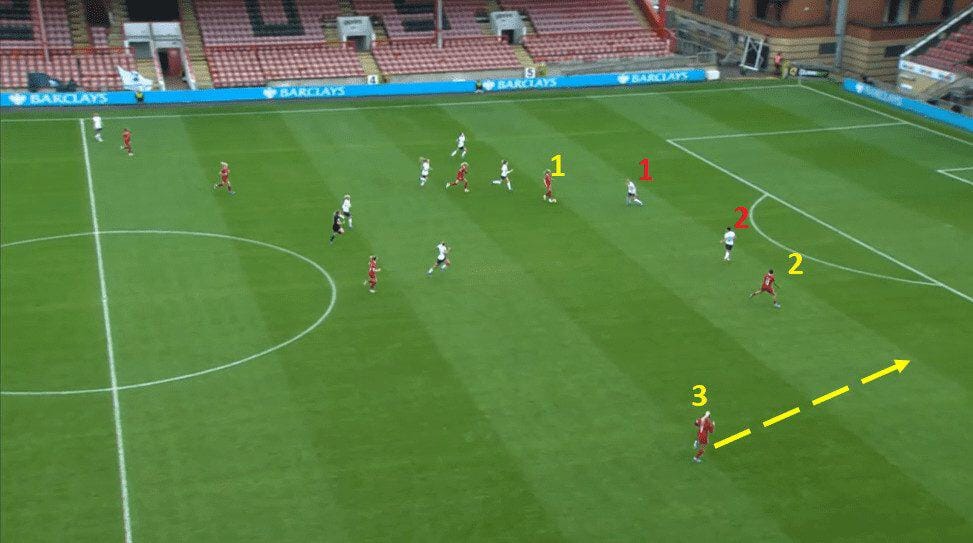
In this above example, Liverpool has played the ball out wide to the left-back Hind,s who then plays the ball into the winger,r who is able to turn and drive the ball forward. Then instantly, you get a 2v2 with Fisk coming to support the attack and take advantage of all this space down the right flank and clip a ball into the back post. However, nothing comes from it.
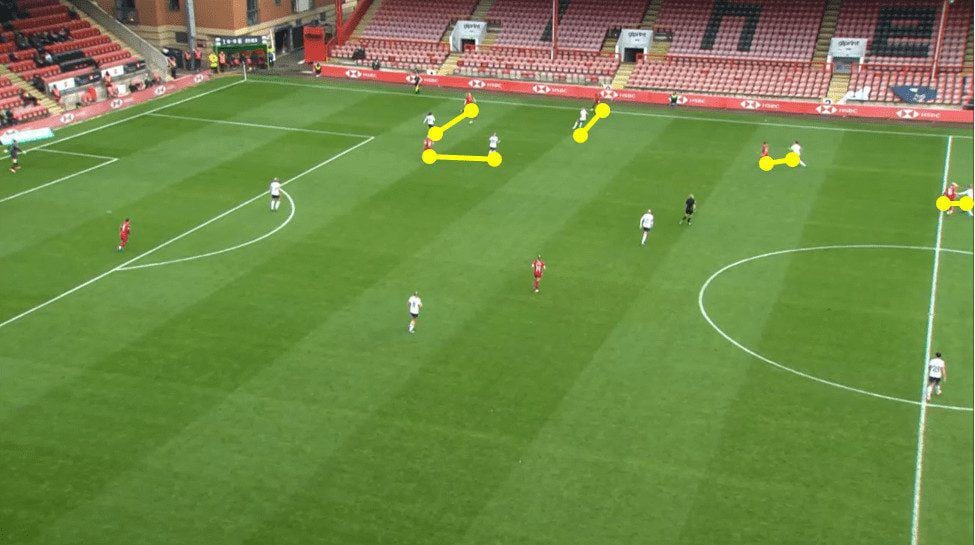
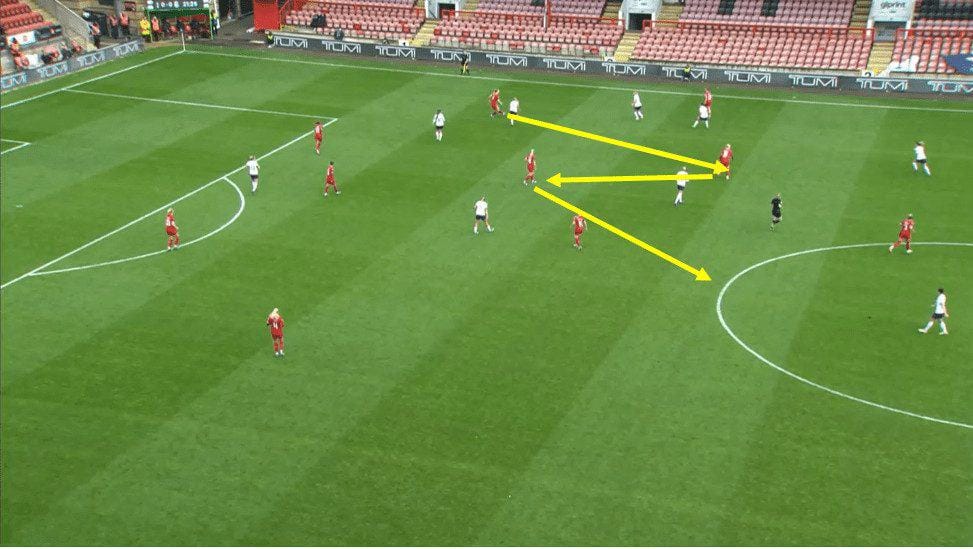
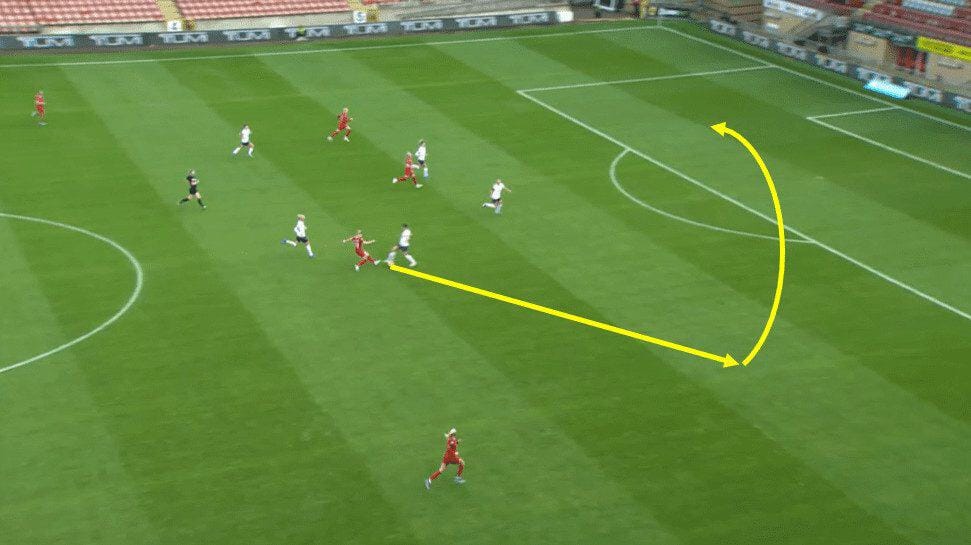
In this above example, Liverpool is forced to play through the Spurs shape and play the ball into a covered player as the option to play around the press is covered up from tight Spurs marking. To deal with this, Liverpool plays quick, sharp passing to try and get the ball away from the region of high Spurs player density and, in two penetrating passes, break through the front two lines of the Spurs press. Creating this great opportunity with a 4v3. Fisk then plays a ball into the box for somebody to attack; however, nothing comes from this chance.
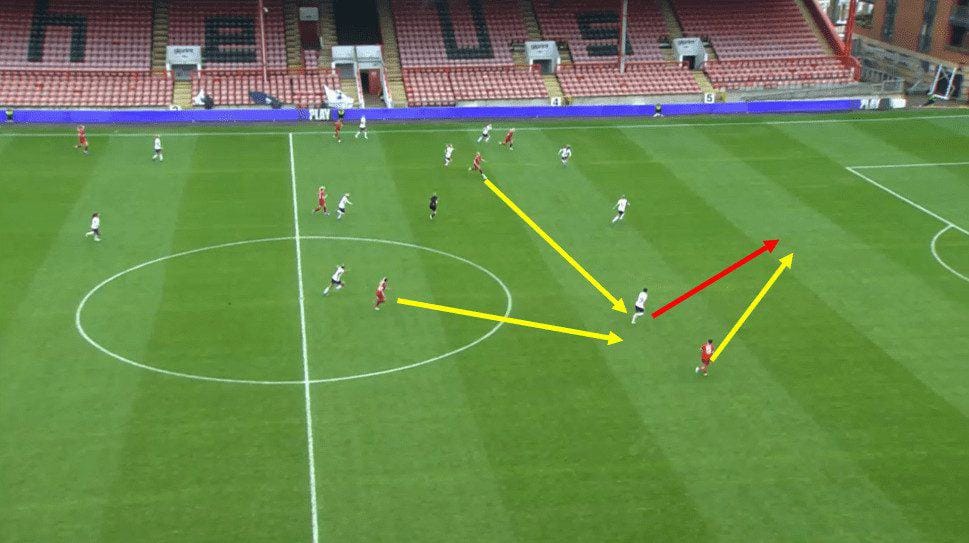
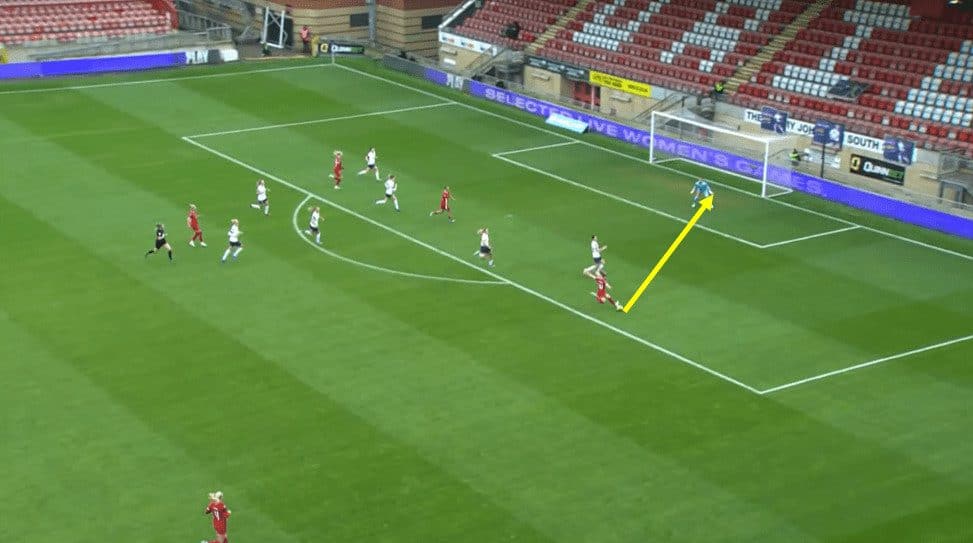
Above is another excellent example of the situations that Liverpool can create. e Holland is patient on the ball and waits for the space to develop with a fantastic run by van de Sanden, which draws Neville centrally. This opens up the space for Hobinger to run into. The ball is played into Hobinger, who can get forward and get a shot away. Neville does well in the end to close off the angle for Hobinger, and the goalkeeper saves the shot relatively comfortably.
Conclusion
Liverpool and Spurs played out a fascinating game over the weekend. Both demonstrated clear intentions to play positive football, with lots of space being created and both teams leaving themselves exposed at times. This led to a game with lots of action to entertain the fans. You can see the intentions and ideas that both sides are trying to implement and how it has allowed them both to have good starts to the 2023/24 WSL season.
Although there may still be a gap in quality between these two sides and the front runners in Chelsea and Arsenal. Both Spurs and Liverpool will undoubtedly be entertaining teams to watch throughout the season.






Comments